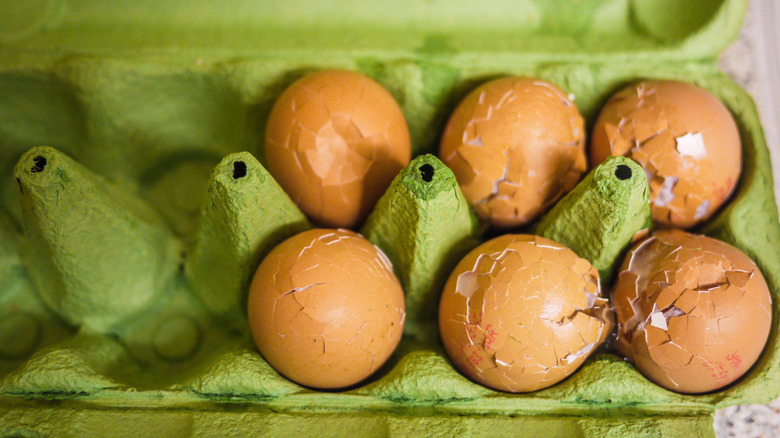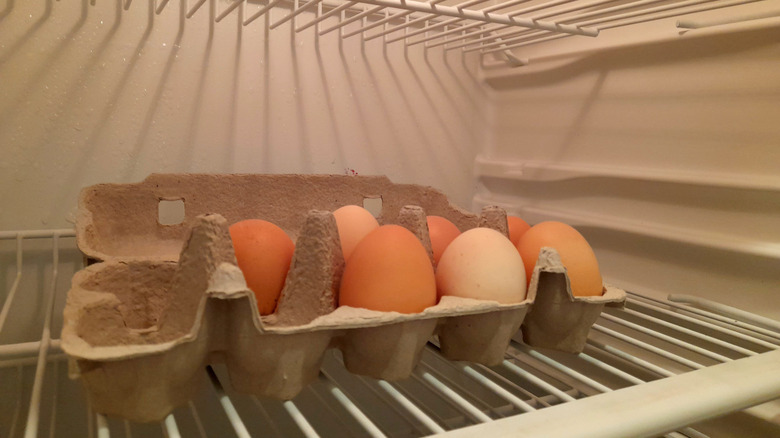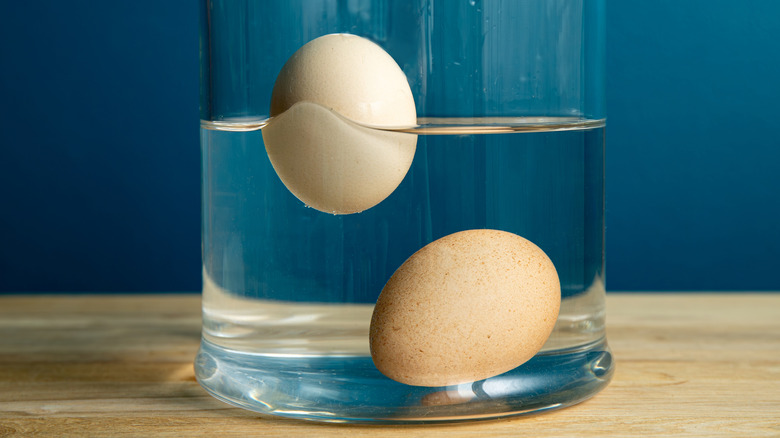5 Signs That Your Carton Of Eggs Have Gone Bad
If you bought too many eggs on your last visit to the supermarket, or you just haven't gotten around to eating them, you may be wondering how to tell if the eggs in your fridge are still good. The truth is that the window of time for eggs' freshness can vary, but when kept in their shells, eggs can still be considered "good" after remaining in your fridge for five weeks. That is a long time to have eggs sitting on your fridge shelf; so long, in fact, that you may lose track of exactly how much time has passed.
When eggs go bad, they can become a home for harmful bacteria like E. coli and other foodborne illness with symptoms like diarrhea, stomach pain, fever, and vomiting. These symptoms can last up to a week and may be enough to make you never want eggs again. To keep the joy of eggs in your life, it's good practice to avoid eating spoiled eggs (or any spoiled food) at all costs, and there are a few ways to tell whether they're safe to eat, or if they should be tossed and replaced with new ones.
Your eggs are smelly
One way to tell almost immediately if eggs have gone bad is to give them a good sniff. In some cases, you may not even need to use the sniff test, because the odor could be quite potent and obvious. If you go to cook an egg and it smells off, it probably is, and should be tossed, along with any other eggs that were in the same carton.
If you can't immediately smell anything odd, but still want to be sure, crack your egg in a separate bowl to sniff it. If it smells off, toss the egg and wash the dish. A smelly egg is a sure sign of bacterial growth. If you've never smelled a rotten egg before, you'll likely know when you find one, because the putrid smell should be enough to deter just about anyone from eating it. Rotten eggs' powerful, sulfurous smell is due to the amino acids cysteine and methionine. Both already exist in the egg, and as it ages, carbon dioxide is released, and eventually creates hydrogen sulphide — also known as the big stink.
Your eggs have visible signs of spoilage
Another way to tell if your eggs have gone bad is to inspect them through sight and touch. Look for cracks in the eggs or a powdery-like texture on the surface of the shell; all are indicates of mold and bacterial growth on the egg.. A solid, crack-free shell is a sign of a good egg. In addition to cracks and powder, be on the lookout for any sliminess on the egg's surface. All of these visual aspects should be enough to deter you from eating the egg.
If the shell looks sound, but you find the color to be off when you crack the egg, or if the egg white and yolk a bit too runny, you may have lower quality or bacterial growth. Egg discoloration will appear as either green or iridescent egg white, which are signs of Pseudomonas bacteria, which can wreak havoc on the body, causing everything from vomiting to sudden vision loss. Other colors to watch out for are black or green spotting in the egg, which also indicates the presence of bacterial growth; egg whites that are safe to eat should be thick and clear.
Try the egg candling method
You don't actually need a candle for the egg candling method, though it does make for a nice effect. The idea behind this approach is to investigate the inside of the egg for defects without cracking it open to find out. Hold a bright light, such as your phone or the flame of a candle, behind your egg (this works best in a dark room), and take a good look at the egg's insides as it's illuminated. A fresh egg will have an opaque shell coloring when a light is shone through it, and you'll be able to clearly see the air cell and the yolk on the inside.
If the air cell in the egg is less than ⅛ of an inch deep, the egg is fresh. While it doesn't mean that the egg is unsafe to eat, older eggs will have a larger air cell than fresh eggs. If the egg is older, you may also notice signs of cracking. If the egg is truly bad and unsafe to eat, the yolk won't be clearly distinguishable, and the egg shell will look murky rather than opaque.
The eggs have been in your fridge long past the date on the carton
Take a look at an egg carton and you'll likely find multiple dates printed on the packaging. One date you may find is the pack date, or the Julian date. This date refers to the date the eggs were packaged and graded by the U.S. Department of Agriculture (USDA). The pack date is also the day the eggs were washed. Washing removes the outer coating of the shell known as the "bloom," which protects the inside of the egg from harmful bacteria. Washed eggs should always be stored in the fridge to stop the growth of bacteria. Eggs are still good to eat as long as they're within 21 to 30 days of the pack date.
Another commonly found date on egg cartons is the sell-by date. It's more for the employees at the grocery store that sold you the eggs; the sell-by date informs the store how long it's allowed to offer the eggs for sale. But even as the date comes and goes, the eggs aren't necessarily bad — just not fresh. The egg-ception, of course, to all of these dates is if you reuse egg cartons. If you decide to swap store-bought eggs for farm-fresh eggs, but want to reuse the carton, the best practice is to cross out any printed dates and write the date on which the eggs were laid.
Your eggs fail the float test
One of the most common egg-testing methods the float test. Whether or not this test is accurate is a subject for debate, but to try it for yourself, fill a glass with water and drop your egg inside. If it sinks, you've got a fresh egg (allegedly). If it floats to the top of the glass, the egg is old. This mysterious egg magic isn't so mysterious at all, though: When eggs are laid, a pocket of air is formed on the larger end of the shell between the egg's inner and outer membranes.
The air pocket starts small, but grows as the egg ages and begins to release moisture. Eventually, the air pocket will grow so large that the egg can float in liquid. While this is a good indicator that the egg is old, it doesn't necessarily mean that the egg is unsafe to eat — just that the quality has likely diminished. It's best to crack the egg in a separate dish and inspect it further if there are no other signs of spoilage present.
If you perform the float test and find that the egg is still good, make sure to either eat it right away or put it in the fridge to steer clear of an unsafe egg cooking mistake, as the water will wash off some of the protective bloom layer on the shell.





